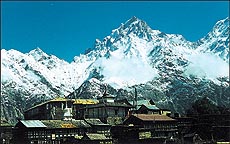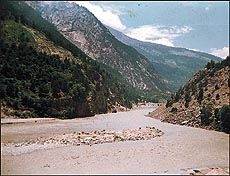The scenic Sutlej valley
Getaway
By Baljit
Singh
THE Beas valley has been on the
tourist map since the early seventies, when it formed
part of the four K’s (Kathmandu, Kulu, Kashmir,
Kabul) of the marijuana-powered hippie culture, whereas
Sutlej valley has remained largely untouched even by the
recent tourist boom. This was partly so because the upper
part of the valley which runs close to the Chinese
frontier remained closed to outsiders until 1989,
deterring both would-be travellers and investments in
infrastructure. And when the restriction was eased, the
Supreme Court clamped down restriction on new
constructions along the river.
 Despite these disadvantages, the long and
deep valley of the region’s most powerful river is
gradually emerging on the tour map and, given the value
of hindsight, avoiding many of the pitfalls of the now
saturated Beas valley. And the engine for its growth has
been the series of dams along the river, running all the
way from below Rampur up to Karcham and into the Baspa
valley almost 100 km upstream. Despite these disadvantages, the long and
deep valley of the region’s most powerful river is
gradually emerging on the tour map and, given the value
of hindsight, avoiding many of the pitfalls of the now
saturated Beas valley. And the engine for its growth has
been the series of dams along the river, running all the
way from below Rampur up to Karcham and into the Baspa
valley almost 100 km upstream.
Rampur Bushehar, the
gateway to this region, is 125 km beyond Shimla. Although
Rampur has a good infrastructure, strictly speaking it is
not a tourist town. For set in narrow and rocky gorges at
an elevation of just over 900 metres, Rampur is hot and
windy in summer and chilly in winter. But its location
and emergence as the hub of a series of new highways
interlinking the Beas basin to the Yamuna (Tons and
Pabbar rivers) means more and more travellers will be
using Rampur as a transit point.
Astride a gorge and set
against the backdrop of rice and almond fields and now
heavy machinery, the capital of the former princely state
of Bushehar is an old town steeped in history with
interesting havelis, temples and palaces, including the
magnificent Padam Palace, dotting the town and the hills
around it.
The town, which was a
centre of trade with Tibet before the occupation of that
country in 1959, still retains its importance as a
trading and manufacturing town. Each November, in the
state-promoted Lavi fair the best of the year’s
produce in wool, timber and metal is displayed. For the
rest of the year too, Rampur with its quaint and
colourful bazars is the best point for buying local and
Kinnauri handicrafts.
 Of its temples, those dedicated
to Bhimkali the region’s presiding deity — are
the most colourful. The best known of these is not in
Rampur but at Sarahan, the former kingdom’s summer
capital 42 km away. Blood sacrifices are performed there
to this day. Of its temples, those dedicated
to Bhimkali the region’s presiding deity — are
the most colourful. The best known of these is not in
Rampur but at Sarahan, the former kingdom’s summer
capital 42 km away. Blood sacrifices are performed there
to this day.
Its famed Bhimkali
temple apart, alpine Sarahan, at a height of 2165 metres
and overlooking the snow-capped Srikhandh Mahadev peak
(5227 metres) is a fledgeling resort town, with trekking
trails over to Taklesh, Chirgaon and Rupin pass.
Temples to Parshuram and
an ancient sun temple lie along the Sutlej bed at Nirmund
and at Nirath, 14 and 13 km from Rampur, respectively.
Dowdy Rampur also sits at the base of a developing alpine
tourism zone, with hotels at Sarahan already functional
and resorts at Sungri and Khadrala under construction.
For the moment, Sungri (2600 m), 60 km away on the road
to Rohru, and Khadrala (2800m) 15 km further on, can be
taken in as day destinations.
Other places of interest
are Bashleo pass (3277 m) some 40 km away and Jalori pass
(3223 m) and Serolsar lake 76 km away on the route to
Manali via Shoja (2683m). The lake is still 12 km
further.
Rampur is also an
important transit point for travellers to the picturesque
Kinnaur valley some 60 km further upstream and as a
gateway to the Sutlej dams zone. Beyond Rampur, all the
little towns along the river are inextricably linked with
hydro-electricity. Jhakri, 11 km away, is the most
important of these. The HPSEB’s regional
headquarters, it is a bustling residential town. Its tier
upon tier of modern housing structures rise up the sheer
left flank of a desolate gorge river like the set of some
bizarre toy city in a Mad-Max adventure.
Jeori, 12 km further
upstream, is an important refuelling station and a bazaar
town for the thousands of construction workers employed
in the Nathpa-Jhakri projects. Both Sholding and Bhabha
Nagar, 20 km further upstream, are also dam towns. Nathpa
and Sanjay Vidyut Nagar, the site for the
over-60-metre-high crest wall of the project and its
underground power house, are a few kilometres from Bhabha
Nagar. Here, in a marvel of modern engineering, a section
of the river has been channelled into the enclosing cliff
to facilitate work.
Wangtu, a little further
on, housed a police check post a few dhabas along
the bridge until July 1987, when a freak cloudburst
brought debris crashing down into the Sutlej and stopped
the roaring waters dead in their tracks. The resulting
lake swallowed up the bridge the road and Wangtu.
Although the river has since eaten away the barrier, the
village never revived and the remains of Wangtu are still
visible in the water.
Beyond the bridge lies
the Kinnaur region Tapri, a construction and road-station
town 10 km from Wangtu, is the first town in this stretch
of the valley. Beyond it, along the river’s edge, is
the cantonment town of Karcham stretching langurously up
to another bridge across the Sutlej. The open-air sulphur
baths a hundred metres short of the bridge, are a welcome
treat in the wind-blown and usually frigid valley.
Across Karcham bridge
the road forks. One segment rises along the blue-green
waters of the Baspa and the other follows the Sutlej to
Powari, a leafy cantonment town and refuelling point, 11
km away. Beyond Powari, while the national highway
continues on to Kaurik and Spiti, a secondary road
doubles back to criss-cross up the mountain to
Kinnaur’s districts headquarters Rekons Peo (2270
m). From Peo, it is 12 km further up the mountain to
picturesque Kalpa, (2960).
For all its hype, as a
new HP tourism resort’ Kalpa is an untrammelled
little village set amidst fields and orchards (apple,
almonds, walnut, chilgoza pines). Stilled by the
impassive Kinner-Kailash massif across the
valley,Kalpa’s few visitors are swallowed up without
a blip, a treat for the travellers escaping the hot
plains and noisy tourist resorts. Those disoriented by
the change can visit Peo’s strikingly modern bazaar
12 km below.
Ribba, home of the
region’s famed grape brandy and a wicked local brew,
Ghanti, is 23 km from Rekong Peo on the road to Kaza.
Information
Getting there: Rampur
is 125 km from Shimla via Narkanda. Kalpa is around 110
km from Rampur (around 345 km from Chandigarh). The road
between Rampur and Wangtu is often damaged, specially
after the first monsoon rains when debris from the past
season’s construction washes on to them. There are
night bus services. From Chandigarh and Delhi to Rampur,
Sarahan and Rekong Peo/Kalpa and a deluxe bus service
from Delhi to Jhakri.
Accommodation:
Rampur: HP
Tourism’s Bushehar Regency — 19 rooms from Rs
600 for regular to Rs 800-1000 for deluxe AC. Several
budget hotels along the road and in town — Rs 100 to
Rs 400. Another budget option is Nogli, 7 km before
Rampur, with two airy guest houses located in open fields
Rs 150-Rs 300.
Sarahan: Hotel
Shrikhand & Srikhand Cottage — Rs 300-Rs 1000.
The Bhimkali temple also lets out rooms. Enquire locally
for guest houses, sometime unregistered.
Kalpa: The
recently renovated Hotel Kinner Kailash Rs 700-1100.
Auctong Guest House — Rs 150 - Rs 250, Shivling
Guest House (near Buddhist gompa) — Rs 150-250.
Rekong Peo: Kailash-view Guest House in front of the PWD
Rest house — Rs 150 - Rs 250.
PWD rest houses let out
rooms for a modest fee (around Rs 100) at Rampur, Jeori,
Sarahan, Karcham, Rekong Peo, Sungri, Khadrala, Shoja.
For reservation details enquire the Assistant Engineer,
PWD, at Rampur, Karcham (for the Sangla valley) and
Rekong Peo.
|

![]()

